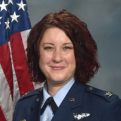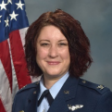Acquisition and the Space Force
Now in the past, we had to actually give money back because it wasn't the right color for the work that I needed to get done. Now with this because I am able to have all of that funding put together, I can work with my users where their priorities are and actually apply that funding to it. It's that much more helpful for me to use every dollar that we receive from the taxpayers, which we're grateful for, for that capability that gets out to the users.
Colonel Jennifer Krolikowski-Stamer
Senior Materiel Leader, Space C2
We have our data layer that we built into our architecture. But because we had that infrastructure there and we were doing it for space command and control, we realized that we had other partners that needed to take advantage of that, and they are wanting to take advantage of what we were doing with data as well. Knowing that we had that commercial capability, they came in to see how we could leverage.
Colonel Jennifer Krolikowski-Stamer
Senior Materiel Leader, Space C2
In the fiscal 2022 Defense Authorization Act, lawmakers expanded the number of projects that would receive “colorless money” for software and IT projects.
Congress approved 12 pilots, up from 9 in 2021, to take advantage of something called budget authority 008 (BA-008). It lets program managers and program executive officers receive access to money that’s good for two years, and also isn’t segregated into the traditional funding lines that were developed for military hardware.
Those 12 pilots, in part, can thank the Space Systems Command’s Kobayashi Maru program.
While this concept has been championed by the Defense Innovation Board, the Section 809 Panel and Ellen Lord, DoD’s former acquisition chief, the Kobayashi Maru program helped prove out the concept over the last two years.
“We have found it extremely successful helping us to make the appropriate trades between doing some legacy stuff which would have been traditionally operation and maintenance dollars versus taking some risk and applying it to new capability in research, develop and technology (RD&T). Now, I don’t have that artificial delineation between RD&T and O&M. I actually maximize the funding that Congress appropriates me to getting capability out there faster, and also decommissioning the legacy systems that I that I don’t need anymore,” said Col. Jennifer Krolikowski, the senior materiel leader for space command and control at the Space Systems Command, on the discussion Technology and Great Power Competition sponsored by Palantir. “Now in the past, we had to actually give money back because it wasn’t the right color for the work that I needed to get done. Now with this because I am able to have all of that funding put together, I can work with my users where their priorities are and actually apply that funding to it. It’s that much more helpful for me to use every dollar that we receive from the taxpayers, which we’re grateful for, for that capability that gets out to the users.”
The colorless money authority lets the Space Systems Command deliver mission capabilities faster, better and cheaper.
For instance in two-plus years since the Defense Department created Kobayashi Maru, the Space Systems Command delivered capabilities across 11 different projects that now have more than 2,600 users.
This success is in stark contrast to the Joint Mission System, which the Air Force spent $1 billion on and had fewer than two dozen users over the last eight years.
Krolikowski said the colorless money helps the Space Systems Command focus on operational acceptance by users first and foremost.
“We kicked off this venture with Kobayashi Maru to bring in those users and operators right from the start and have that dialogue, that continuous communication, with them, one to not only make sure I understand where their pain points are and what is it that they are looking to better their mission or to build to better performance for their mission, but also to give them back some expectation management of what we can do on the acquisition side from either a technology perspective or a timeline for what it would take to get to alleviating some of those pain points,” she said. “But having that continuous dialogue back and forth, over the last couple of years has been extraordinarily helpful. We look to make sure we have that dialogue and that communication back and forth with our users so that they actually want to use the software when we deliver it.”
Krolikowski said the pilot using colorless money also has led to a culture change not just with the user community, but at the leadership level too.
“My leadership is one of my users and stakeholders. The vision Gen. [Jay] Raymond, [chief of space operations] has for the Space Force and what he needs for operational space command and control as well as what the combatant commander needs from their perspective, I take those visions and I balance that with what the operator pain points are as I build my software,” she said. “I can build it in such a way that it stays flexible, that it can scale and be extensible. I can actually start to balance both sides from a top down and a bottoms up approach to be able to actually extend that software to address whatever changing priorities there are, or changing threats there may be. But I bring all of the users that I have in there so that my software is actually built appropriately.”
Funding and leadership support are two legs of a three legged stool. The third leg is the technology architecture.
Krolikowski said by using a software stack that is made up of different but complimentary technologies, the Space Systems Command can bring in both non-traditional contractors and focus on the data to drive decisions.
“By us breaking that stack apart and actually getting best of breed in each of those areas, we’re able to take in that stuff from industry that is awesome and help accelerate the stack of IT in general,” she said. “Case in point, we have our data layer that we built into our architecture. But because we had that infrastructure there and we were doing it for space command and control, we realized that we had other partners that needed to take advantage of that, and they are wanting to take advantage of what we were doing with data as well. Knowing that we had that commercial capability, they came in to see how we could leverage.”
Listen to the full show:
Copyright
© 2025 Federal News Network. All rights reserved. This website is not intended for users located within the European Economic Area.






